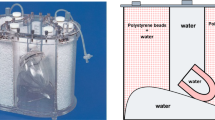Abstract
A quantitative dual-isotope single-photon emission tomography (SPET) technique for the assessment of lung ventilation (V) and perfusion (Q) using, respectively, technetium-99m labelled Technegas (140 keV) and indium-113m labelled macro-aggregated albumin (392 keV), is presented, validated and clinically tested in a healthy volunteer. In order to assess V, Q and V/Q distributions in quantitative terms, algorithms which correct for down scattering, photon scattering and attenuation, as well as an organ outline algorithm, were implemented. Scatter and down-scatter correction were made in the spatial domain by pixel-wise image subtraction of projection-dependent global scattering factors obtained from the energy domain. The attenuation correction was based on an iterative projection/back-projection method. All studies were made on a three-headed SPET system (Trionix) with medium-energy parallel-hole collimators. The set of input data for quantification was based on SPET acquisition of emission data in four separate energy windows, the associated cumulative energy spectra and transmission data. The attenuation correction routine as well as the edge detection algorithm utilized data from 99mTc transmission tomography. Attenuation data for 113mIn were obtained by linear scaling of the 99mTc attenuation maps. The correction algorithms were experimentally validated with a stack phantom system and applied on a healthy volunteer. The mean difference between the corrected SPET data of the dense stack lung phantom and those obtained from the corresponding scatter- and attenuation-"free" version was only 1.9% for 99mTc and 0.9% for 113mIn. The estimated fractional V/Q distribution in the 3-D lung phantom volume had its peak at V/Q=1, with a width (FWHM) of 0.31 due to noise, particularly in the 113mIn images, and to partial volume effects. For a healthy volunteer, the corresponding values were 0.9 and 0.35, respectively. This method allows accurate assessment of radionuclide distribution on a regional basis. For basic lung physiology and clinical practice, the method allows assessment of the global frequency functions of the V, Q and V/Q distributions.
Similar content being viewed by others
Author information
Authors and Affiliations
Corresponding author
Additional information
Received 28 September 2001 and in revised form 18 February 2002
Electronic Publication
Rights and permissions
About this article
Cite this article
Sánchez-Crespo, A., Petersson, J., Nyren, S. et al. A novel quantitative dual-isotope method for simultaneous ventilation and perfusion lung SPET. Eur J Nucl Med 29, 863–875 (2002). https://doi.org/10.1007/s00259-002-0803-8
Published:
Issue Date:
DOI: https://doi.org/10.1007/s00259-002-0803-8




